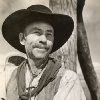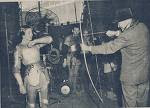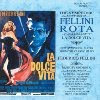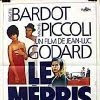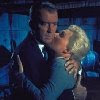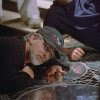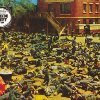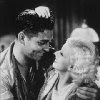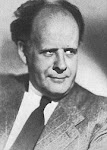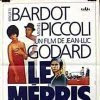Tuesday, September 1, 2009
Aimez-Vous Sarris: Postscript
In my essay, I concentrated on one, and only one, hallmark of the auteur, the director’s indelible stamp of his personality, the “figure in the carpet,” the stylistic and thematic elements unique to that particular filmmaker. In his 1962 essay, however, Sarris identifies three primary keys to recognition of an auteur:
1. “The first premise of the auteur theory is the technical competence of a director as a criterion of value.”
Here, Sarris argued that “if a director has no technical competence, no elementary flair for the cinema, he is automatically cast out from the pantheon of directors. A great director has to be at least a good director. This is true in any art….”
Ironically, when P. Adams Sitney anthologized Film Culture essays in 1970’s The Film Culture Reader, Jonas Mekas, the editor-in-chief and publisher of the magazine, in an essay entitled “Notes on the New American Cinema” bemoaned “the guardians of Cinema Art whop accuse the new film-maker of shaky camera work and bad technique.” Mekas was writing of what we then called “experimental cinema”: the work of Stan Brakhage, Maya Deren, Kenneth Anger, Mekas himself, and many others, films which by categorical definition one might not expect to be technically proficient.
Unfortunately, the non-auteur may be heard to argue that the films of, say, Ed Wood, are technically inept or mostly so, yet the stamp of Wood’s personality is all over them, from the ludicrous titles (e.g. Plan Nine From Outer Space) to sudden intrusion of another actor in scenes the late Bela Lugosi was unable to finish before his demise. But I play devil’s advocate: if technical proficiency were the only hallmark of the auteur, Sarris would have said so. Wood’s works belong to that genre of film known as the “cult film,” to which few auteurs would fit.
Moreover, technical inconsistencies too often can be explained by the collaborative nature of the medium, a director not always having access to a crew he or she might prefer. John Huston, for example, preferred working with the famous British lighting cameraman Oswald Morris and availed himself of that cinematographer for several of his better films (The African Queen, Beat the Devil, and – pace, Mr. Sarris -- Moby Dick). Hitchcock was always best served, especially when shooting in color, by Robert Burks, and his stable of regulars included editor George Tomasini and art director Hal Pereira. When a filmmaker gets used to using only the best talent, she or he sometimes finds working with others uncomfortable.
2. “The second premise of the auteur theory is the indistinguishable personality of the director as a criterion of value.”
Here, Sarris relegates Ingmar Bergman to a lesser status than George Cukor, a
placement guaranteed to upset the average art house patron. But Sarris explains that Bergman’s “technique never equaled his sensibility,” and for that reason he exalts Douglas Sirk and Otto Preminger over Joseph L. Mankiewicz and Billy Wilder. Sarris states that the latter two filmmakers lacked “adequate technical mastery,” while the former two, in their “miscellaneous projects reveal a stylistic consistency.”
That one Mankiewicz or Wilder film is more popular than a similar or contemporaneous work by Sirk or Preminger does not, per se, disprove Sarris’ auteurist pronouncements, although it does suggest that our appreciation of this or that film and our dislike for another is merely indicative of a point I made in the main essay: all aesthetics in the final analysis boil down to personal taste. Nevertheless, I am prepared to argue, as would Sarris, that Sirk’s 1958 The Tarnished Angels is a better movie in every way than his émigré colleague Wilder’s Love in the Afternoon, made just a year earlier. (Certainly, it might be argued that I am comparing apples to oranges in that the one is an air show melodrama while the other is a frothy if sophisticated romance, but that is besides the point: one is simply better made than the other.)
I could similarly argue that in the same time-frame, while Mankiewicz was turning out The Quiet American, based on a Graham Greene novel, Preminger was helming Bonjour Tristesse, adapted from the novel by Françoise Sagan. I could but I will not. The auteur theory is flexible enough to allow good films to be compared to relatively mediocre ones – “relative” because, in retrospect, the Preminger film seems dated, while the Mankiewicz holds up admirably when viewed back to back with the recent remake by Phillip Noyce. (Interestingly, it was Huston who asked, why remake a good movie? Hollywood remade Moby Dick, with Franc Roddam directing Patrick Stewart in the Ahab role. It was a disastrous picture that did not work on any level. For all the criticism Sarris planted on Huston for casting Gregory Peck as the white whale hunting madman, Stewart pales in comparison.)
3. “The third and ultimate premise of the auteur theory is concerned with
interior meaning, the ultimate glory of the cinema as an art.”
By “interior meaning,” Sarris, apologizing if he sounds “unduly mystical,” means an “extrapolation” from “the tension between a director’s personality and his material,” the “intangible difference between one personality and another, all other things being equal.” I think what Sarris is basically getting at is this: If one handed, say, Gide’s Vatican Cellars to a competent screen writer and passed on his or her script, assuming it is a fairly faithful yet cinematic treatment of the story, to both Joseph Losey and Carol Reed, telling both directors they must follow the screenplay as closely as possible but allowing them to choose their own cast, cinematographer, editor, &c., not only would two very different movies result, it’s a safe bet that Losey’s would be better. Not only is the material more to his sensibilities (after all, this is the man who made The Servant), he is the more cinematically inventive of the two directors.
As an aside, I recently saw a few minutes of Reed’s The Man Between on Turner Classic Movies, and if I hadn’t noticed that the cast included James Mason and Claire Bloom darting here and there through bombed-out East Berlin, I would have sworn that those chiaroscuro sequences with tilted camera angles were shots from The Third Man. Only Orson Welles and Valli were missing. Reed was not inventive. He found a cinematograhic trick that worked and kept using it, as if it were appropriate for all his pictures.) It became simply a fetish.
To illustrate “interior meaning” Sarris recalls a sequence in Renoir’s Rules of the Game in which the director (acting a role in his own film) “…gallops up the stairs, turns to his right in a lurching movement, stops in hop-like uncertainty when is name is called by the coquettish maid, and then, with marvelous postreflex continuity, resumes his bearishly shambling journeyto the heroine’s boudoir. If I could describe that musical grace note of that momentary suspension, and I can’t, I might be able to provide a more precise definition of the auteur theory. As it is, all I can do is point at the specific beauties of interior meaning on the screen and, later, catalogue the moments of recognition.”
I have my own catalogues of “moments of recognition,” including the scene in Welles’ Touch of Evil where Quinlan and his yes-men wind in and out of each other’s paths as they cross a room in the border town jail, their dialogue sometimes interrupting each other, sometimes superimposing; the scene in Minelli’s Some Came Running where Dean Martin, hospitalized in a knife fight, lies in bandages half-naked in a hospital bed, still wearing his Stetson (which he never removes in the entire film), and the scene in Hitchcock’s Rear Window where an elegantly dressed Grace Kelly comes into Jimmy Stewart’s apartment after an evening engagement and leans over to kiss him as he sleeps.
This latter sequence epitomizes Hitchcock, I think. Burks shot it in low light where less talented cinematographers might have flat-lit it, and it opens the sequence rather than climaxes it; moreover, the shot is step-printed, not shot in slow motion, which would have been cheaper but would have produced a less dramatic effect. Hitchcock’s technical artistry always equaled his sensibility. He was inventive. Think of the opening sequence in Vertigo (generally acknowledged as his masterpiece). Detective Jimmy Stewart is chasing a criminal across a San Francisco roof only to slip and fall to almost certain death many stories below, except that he manages to grasp hold of a rain gutter. Then, we see him glance at the street below, the camera both pulling back and zooming in, a visually confusing shot -- imitated by many other filmmakers since -- that immediately informs us the man suffers from acute acrophobia.
Finally, Sarris emphasizes the importance of evaluating a director from examination of his entire career whenever possible, noting that a scene utilizing "an essentially feminine narrative device" in a 1935 Raoul Walsh film with George Raft was "later amplified in High Sierra [1941] with Humphrey Bogart.” Sarris found some threads of the figure in the carpet of Walsh’s movies. As I suggested in my essay, filmmakers, like novelists, always make essentially the same film. What is Fellini’s Nights of Cabiria but a dress rehearsal for La Dolce Vita?
Wednesday, August 12, 2009
Aimez-Vous Sarris?: New Perspectives on the Auteur Theory
I just watched John Ford's Stagecoach on Turner Classic Movies. I think I've seen it six or seven times, but each time I see it again, I marvel at its brilliance. It is that rarest of movies: one that combines both action and character studies. It used to be said that novelists always write the same book, and there's a strong argument to be made for Hemingway's novel, Islands in the Stream being nothing but a second take of his earlier work, To Have and Have Not. And surely the young handsome Henry (better known as the Ringo Kid) of the black and white Stagecoach (1939), is nothing but a youthful version of Ethan Edwards in Ford's color masterpiece, The Searchers (1956), where he's gone long in the tooth. The point is, film directors, like novelists, are the authors of their works. As the French film critics -- a lot of them, eventually filmmakers themselves -- used to say, good directors are auteurs.
I bring all of this up because I recently read a piece by David Denby in The New Yorker glorifying the career of the relatively obscure Victor Fleming who, admittedly, would deserve at least a line or two (or a footnote at the very least) for having worked on both Gone With the Wind and The Wizard of Oz in the same year, 1939. But that was the year that Ford made Stagecoach as well, and as much as I like both of the Fleming films, I would take neither of them into forced exile on a desert island, allowed only a DVD player and a couple of dozen motion pictures. I suspect The Searchers would be one of them.
In "The Real Rhett Butler," Denby does a fine job of chronicling Fleming's career, and had the latter directed nothing more than his 1932 Red Dust, he would be justifiably celebrated. And who can deny that The Virginian (1929) has its memorable moments (remember Gary Cooper saying "Smile when you say that"?). Certainly Bombshell ('33), Treasure Island ('34), and Captains Courageous ('37) are enjoyable pictures, packed with what Denby characterizes as "brusque masculine humor," but Denby glosses over Fleming's many mediocre movies, things like Mantrap, Hula, and White Sister.
The news peg for Denby's piece (published in the magazine's "Critic at Large" section) is the publication of two books that illuminate Fleming's career: one, a biography by Baltimore Sun film critic Michael Stragow; the other, a revisiting of the making of Margaret Mitchell’s novel into film by Molly Haskell. Interestingly, Haskell happens to have been married to another film critic and historian, Andrew Sarris. It was to Haskell that Sarris dedicated his 1968 paperback book, The American Cinema: Directors and Directions 1929-1968, a work I've long believed deserving of a newer edition, a mammoth undertaking given the number of films that have been made in the past forty years.
Now it so happens that although Denby ridicules the auteur theory, most of the films of Fleming he likes best happen to be the same ones Sarris set off in italics in his filmography of Fleming, his means of identifying the masterworks of each filmmaker he discusses, distinguishing them from lesser works in regular type. Sarris also divides American filmmakers into categories with novel if sometimes cloying titles, e.g. "Pantheon Directors" (the Hitchcocko-Hawksian school), "Lightly Likeable" (people like John Cromwell and Michael Curtiz), and "Strained Seriousness" (Stanley Kubrick, Sidney Lumet, John Sturges). Sarris put Fleming into an innocuous category called "Miscellany").
To impart some indication of how I value Sarris' book, I must add that I have two copies; one that I bought and one given to me by Stephen M. Silverman, who wrote a very fine book on The Films of David Lean. My older copy is tattered, the result of a teething puppy's chewing frenzy, and well thumb-smudged from constant and repeated referencing. Yet, it is never far from my TV monitor. The other, Stephen's, a reprint, is safely put away, opened only when I have misplaced the first edition.
Curiously, although he mentions Pauline Kael, one of his predecessor film critics at the New Yorker, Denby says nary a word about Sarris. And this despite the fact that he uses the occasion of the publication of the Fleming books in a vain attempt to elevate the man to Sarris' so-called "Pantheon." I say vain, because despite all of Denby's praise, despite his glowing re-views of the half dozen works by Fleming that could justifiably be called great, nothing Fleming did, and certainly not his entire canon, can be said to measure up to the individual movies and collected works of Ford, Hawks, Hitchcock, Lang, von Sternberg, Renoir, or Welles. Give me a DVD of the restored Touch of Evil and you can have a hundred DVD's of Tortilla Flat, the great Spencer Tracy notwithstanding.
The long tracking shot across the
Fleming knew nothing about moving actors through the frame as Welles does in a Touch of Evil city hall sequence featuring Heston, Ray Collins, and Joseph Calleia weaving in and out of each other as they speak what might be throw-away lines in another filmmaker's hands. All Welles films, as do all films by Ford, Hawks, Hitchcock, and the other American auteurs, have this distinctive, signature style, what British film critic (and editor of Sight and Sound) Penelope Gilliat called "the figure in the carpet." Fleming did not, and that is the plain truth of the matter.
I was browsing in our local Half Price Books the other day and was amazed to learn that Da Capo has reprinted Andrew Sarris's American Cinema with a cover blurb on the back explaining the qualities that distinguish an auteur director from a studio hack: independence of mind, a willingness to buck producers, studio heads, and the money men; placing a personal stylistic or thematic stamp on the movies made, &c. I thought of Sarris's "Pantheon" directors vis-a-vis people like Victor Fleming. Both he and Welles were subjected to studio medling; for example, Welles' The Magnificent Ambersons was re-edited by the studio while the filmmaker was off in South America doing It's All True, a kind of documentary about native life in
It's very likely Denby would agree that the finished Ambersons is a very good picture, but one wonders how much better it would have been had Welles been allowed to cut it himself and present it according to his own plan. (It’s said that Welles demanded complete control over Touch of Evil, but then he had Charlton Heston in his corner (the actor said he would not star in the film unless Orson helmed). The result is a masterpiece by anyone's standards.
Contrast this 1958 Welles film noire with "Fleming's" GWTW. Perhaps Denby should have perused a few other sources prior to attempting to elevate Fleming to the status of an American auteur. Take for example Lawrence Grobel's 1989 biography, The Hustons: The Life & Times of a Hollywood Dynasty. Grobel implies that John Huston would have merited a higher placement in the hierarchy of genius of auteur theorists like Sarris had the man not believed in tackling disparate genres and ambitious, at each outing tackling new, seemingly more difficult projects unlike previous efforts. But, then there are as many Annies in the Huston canon as Maltese Falcons.
In any case, Grobel interviewed Oswald Morris, the British "lighting cameraman" (
Morris told Grobel: "David Selznick genuinely believed that the producer was more important on a film than the director." Anyone who doubted this, Grobel wrote, "would be asked to name the director of Gone With the Wind. 'Nine out of ten people couldn't tell him,' Morris said, 'and then he'd ask who produced it, and they'd all say David Selznick. That was his set piece.'" Huston ultimately backed out when differences arose, including concentration on Ms. Jones to the detriment of Hemingway's intentions. Instead of helming A Farewell to Arms (Selznick hired Charles Vidor to direct what turned out a flop), Huston made Roots of Heaven in Africa, and if anyone wonders why that movie was such a loser, take a look at the Clint Eastwood picture, White Hunter, Black Heart, based on Huston friend Peter Viertel's novel of the same name. Huston had a habit of signing on to direct pictures in which he had little interest, viewing the project as an opportunity to travel, go hunting, &c. , as the Grobel biography illustrates again and again.
Years ago, I had a spirited debate about the auteur theory with one of Denby's predecessors in the film critic's slot at The New Yorker, the late Pauline Kael. She was a guest lecturer in a course I took at the
Now, I don't mind admitting -- 46 years later -- that 8 1/2 was vastly overrated at the time. To my mind, it doesn’t hold a candle to Fellini’s La Dolce Vita, made the previous year and representing not only his own finest work but the full flowering of Italian neo-realism. But I suspect that even Kael had reacted so negatively to Fellini's dreamy, expressionistic, autobiographical work because it insisted that he was an auteur; that is, it had stylistic conventions and bore the indelible stamp of its director's personality. And Kael was one of the staunchest opponents of auteur criticism. At times it almost seems as if she were writing with a grudge against not only Sarris but the entire British and American auteur crowd, which was by then represented by an English edition of the French magazine, Cahiers du Cinema.
The auteur theory reminds me of the famous dictum of the theoretical physicist who said that those who are not astonished by the implications of quantum mechanics have failed to grasp its meaning. Denby betrays a naivete and misunderstanding of auteur theory. Just one example of this confusion is his apparent belief that since not all auteurs turn out perfect pictures each time they call “wrap” on a new one, and because some non-auteur directors make masterpieces themselves now and then, the auteur theory is thus disproved. This is hardly the case. Once can use examples from Sarris's italicized examples of worthy auteur movies for a given year and compare and contrast them with lesser works from non-auteurs the same year to clarify this point. For example, in 1958, when Hitchock was shooting Vertigo, William Wellman was making Darby's Rangers and Lafayette Esquadrille.
Now, take up, say, Steven H. Scheuer's Movies on TV (1990 ed.) and check out his ratings and reviews of these three movies. (The fact that Wellman made two films in '58 only proves he was more in demand and perhaps planned his works with less deliberation and more subservience to studio demands.) Scheuer, giving Vertigo four stars (his highest rating), calls the movie "a spellbinding work" and devotes about three inches of a column in his description of it. He says of Darby's Rangers, reviewed in less than in inch of space and given two stars, that it's an "uneven war drama," and of Lafayette Esquadrille, given one and a half stars and meriting only a one-sentence description, that it's "corny and melodramatic." (Of course, Scheuer may have had an aversion to Tab Hunter, who starred in the second film.)
Now, unless he or she is a war film nut, I'll wager you can look hard and long and never find a cineaste who prefers these two combat pictures over Vertigo. Yes, it is true that Wellman's Wild Boys of the Road, Nothing Sacred, and The Oxbow Incident are all finer works than Hitchcock's Jamaica Inn, Mr. and Mrs. Smith, and Lifeboat, but that is besides the point.
I'm willing to wager that if you walked into any of these lesser movies by Hitchcock well into the action you would, within a very few minutes, know exactly who directed it (and I am not thinking of those "signature" scenes where Hitch makes an appearance himself, whether it is missing a bus during the opening credits of North by Northwest, walking across the screen carrying a double bass fiddle in Strangers on a Train, or exiting a pet shop in San Francisco with a couple of well-coiffed terriers in tow in The Birds. I am talking about the technique, written about extensively by Robin Wood and others, of psychologically putting the audience into the position of the protagonist by use of subjective camera angles, as when he has Marnie (in the film of that name) sneaking into an office with theft on her mind and cutting away to views of what she sees in tracking shots so that her slow, stealthy creeping is shown from her point of view (and therefore ours). This was part of Hitch's genius. He discovered this technique and used it to great effect; it has been much imitated (where would the early Brian De Palma be without Hitchcock) but never mastered so brilliantly.
Like Huston, Wellman sometimes found remarkable visual equivalents to the emotions of his characters as when, in the latter's Track of the Cat, he shot in color but emphasized black and white (including the heavy snow of the mountains), reducing the foreground visual elements to precious few colors so that when Robert Mitchum goes out to destroy a mountain lion that has been killing his livestock, his red woven coat stands out starkly in an almost 3-D effect. (Spielberg must have had this film in mind when he follows a Jewish orphan in red in the otherwise black and white Schindler's List. As the great Jay Leyda once observed, “films beget films.”) For all his reputation as a "
Or, take the argument from genre. Some anti-auteurist critics may be heard to argue that the indelible stamp of an auteur derives from their propensity to make the majority of their films within a particular genre: Ford (westerns), Capra (socially-conscious comedies), Sirk (sophisticated, socially-conscious soap operas), and so forth, so it's only natural that one might miss the first 15 minutes of a Ford, Capra, or Sirk film and simly guess the director's identity. And for that matter, these critics argue, some directors held in low esteem by the auteurists sometimes make superior westerns, comedies, and soap operas. For example the themes of The Unforgiven by Huston are quite similar to those of The Searchers by Ford. When Groble's biography of Huston is consulted, however, one realizes that the auteur of The Unforgiven was Burt Lancaster, who did not get along with Huston and who had a friend and supporter in the money-man, his producer partner, James Hill. At some point while making the film, Grobel reveals, Huston simply gave up.
Denby's basic premise is flawed. In championing Fleming, he writes:
"The auteur-theory critics who, in the nineteen-sixties and seventies, went wild over Cukor, Hitchcock, Preminger, John Ford, Howard Hawks, Ernst Lubitsch, Josef von Sternberg, Frank Capra, and many other directors of the late silent and early sound periods, ignored Fleming...."
Wrong. Sarris, for example, as has been mentioned, not only included Fleming in American Cinema, he lists some 42 Fleming movies and italicizes ten, indicating merit, whereas he could simply have placed Fleming in “Subjects for Further Research,” the home of Tod Browning, Sidney Franklin, and Henry King, rather than in “Miscellany.” It might be said that one out of four is not bad, but one suspects Sarris failed to see all of the movies he lists; after all, why would anyone resuscitate Fleming's 1925 silent adaptation of the Joseph Conrad novel, Lord Jim when the serviceable (and at times engaging 1964 version by Richard Brooks (categorized as "Strained Seriousness," along with Jules Dassin, Stanley Kubrick, and Sidney Lumet!) is available on DVD?
But, back to Denby:
"...[Fleming] made a number of entertaining movies in the nineteen-twenties and his two super-productions of 1939...likely the most widely seen movies in American film history -- not just good pictures but films that have entered the unconscious of generations of moviegoers...."
Wrong again. One suspects that Denby is taking at face value the opinions of Flemings work as asserted in the two books he's critiquing, Stragow's and Haskell’s, begging the question, just how many Fleming works did these authors sit through? I cannot recall the estimates and statistics, but a significant number of pre-WWII movies, including a huge number of silents (a lot of them on brittle, highly flammable nitrate stock, sometimes found as dust in their original cans in old studio vaults) are simply no longer available for viewing, whether in 35- or 16-mm. or in VHS, video disc, or DVD format. One has to wonder, for example, if Denby, Stragow, or Haskell caught a screening of Fleming's 1922 Red Hot Romance, or his 1924 Empty Hands, or his 1926 Blind Goddess. (The only reason I saw every film Josef von Sternberg ever made – save the unfinished, brilliant I, Claudius – was because he did a seminar at UCLA in, I think, 1966. He screened them all for us and I befriended him simply by asking that he inscribe his autobiography, Fun in a Chinese Laundry.)
When Denby remarks that Fleming made "a number of entertaining movies" in the 20's and 30's, one might observe that "2" is a number, as is "3." From that period, Sarris italicizes nine such films, possibly suggesting that Fleming had reached his peak in those years. Of his 1940's output, Sarris heralds only 1943's A Guy Named Joe, which Scheuer gives only 2 1/2 stars, and although Stephen Spielberg obviously thought enough of it that he remade it in 1989 as Always, that film, too, is fairly mediocre.
If GWTW and Oz "entered the unconscious of generations of filmgoers," it was not necessarily the direction of Fleming that worked the magic. After all, when the former film was made, censorship in Hollywood had gone to such extraordinary lengths that men could not be shown on bed with a woman unless one of the man's legs was on the floor; it was, therefore, shocking to audiences to hear Rhett quip, "Frankly, my dear, I don't give a damn." (The word, "damn," was not allowed, unless it was essential to the scene and faithful to the adapted work.) And how many people prior to the latter film saw movies with flying uniformed monkeys and a witch who cackled, "I'll get you and your little dog, too"?
The point is, Sidney Howard, Ben Hecht and three other writers put Margaret Mitchell into film form for Fleming (who, Denby allows, shared directorial duties with William Cameron Menzies, Cukor, Sam Wood, and others) for GWTW, and Fleming had Noel Langley, Forence Ryerson and twelve other writers scripting Oz, and direction of that film was aided by Mervyn LeRoy and King Vidor. Whose personality do we see in these two films? My argument is simply that it is difficult if not impossible to tell. They may be good movies, but they're MGM extravaganzas to me. MGM was the Time magazine of film studios, and when a writer worked for Time, he quickly found out that there was a "Time style,” by which I mean formal conventions to which the writer adhered or was shown the exit.
Finally, Denby utters the ultimate canard:
"...[
Wrong. All such directors only occasionally make truly great movies, and the greatness of the movies is as much a matter of their message as the telling of it, or of the lucky concatenation of circumstances that saw, for example, S. N. Behrman contributing dialogue to scenes photographed by William H. Daniels in mediocre director Rouben Mamoulian's 1933 Queen Christina. And Spielberg is hardly one to quote in defense of anti-auteurism. His movies have less personal style than those of, say, John Sturges. I fully suspect Sarris would place Spielberg in "Strained Seriousness," "Lightly Likeable," or "Less Than Meets the Eye." Spielberg has turned out a few brilliant pictures (one thinks of Jaws, which for all its commercialism is a well-paced thriller with superb acting); Close Encounters (as close to a spiritual experience as could be filmed), and Minority Report (which, despite its debt to the late great Phillip K. Dick, is nevertheless one of the most believable, well-executed SciFi films ever made).
Well, really, who can deny that Saving Private Ryan is a masterpiece of the war film genre?
But that is besides the point: the closest Spielberg comes to a stamp of personality -- a thematic and stylistic thread running through almost all his films, and especially his later ones, is his botched, cloying endings. Even in Ryan, for example, do we really need an elderly veteran, played by Matt Damon, collapsing in tears upon locating the
These lapses in taste and failures of discrimination suggest that the director is self-indulgent and could never, ever come up with anything so powerful for an ending than that of Ford’s Searchers: a shot of Ethan Edwards (John Wayne), framed in the door of a prairie sod house as he leaves the security of family and friends for the only thing he has known, the life of a long rider.
And although Ford had his disasters (one of them is The Long Gray Line (inexplicably italicized by Sarris, incidentally – no two auteurists can agree on everything), and although he, too, was given to sentimentality from time to time (and how!), nothing by Ford comes close to being as godawful as Spielberg's duds, films like 1941 and Hook. Simply put, you could never walk into a Spielberg movie 15 minutes after the opening and guess who made it, something which cannot be said of Ford. You may like it, you may know it is awfully well made, but you can't say who made it if you didn't know in advance or catch the credits.
Oddly -- I suppose Jungians would call it a synchronicity -- a friend from Dallas (John W. Gaston, a former professor of theatre) sent me a copy of the May 29, 2009 Chronicle Review, an educational journal my friend says is mostly published so that its authors do not perish, if you know what we mean. This issue, which came out just four days after the New Yorker piece by Denby, had an essay titled "The Color of Minnelli: His Style Was Substance," by Thomas Doherty, a Brandeis University professor. In it, he quotes Sarris, dubbed "the high priest of auteurism," as observing that Vincente Minnelli was "more a stylist than an auteur," a rather meaningless phrase that taken out of context might lead the reader to think Sarris himself thought that style played a relatively minor role in auteur criticism. Hardly.
Doherty also quotes Emanuel Levy's book about Minnelli, Dark Dreamer, as implying that the filmmaker was neurotic and sought to put on the screen the visions of a man "tormented and dark, possessed of a soul whose gaudy spectrums mask inner demons." (Where, oh where is Susan Sontag now that we really need her? Her essay, "Against Interpretation" would help rescue this director of stylish entertainments from such crypto-Freudian analyses.) In another work about Minnelli, an anthology of world-wide criticism, Doherty references an essay by Joe McElhaney, Hunter College film professor, who "lauds the body-switching gender farce Goodbye Charlie (1964) and the leaden The Sandpiper (1965) as 'two very uneven but interesting and important films,'" and concludes that McElhaney "might be dipping too deeply into the auteurist Kool-Aid."
Now, just what does that mean? As urban slang, "Kool-Aid," came into being in the wake of the Jim Jones affair in
I, for one, understand McElhaney's point. It was the same point that guided the curator's philosophy of the Cinematheque, whose Henri Langlois, a devout auteurist, believed that no movie is bad, that all movies have at least something in them, if only a scene -- even a few frames -- that entertain, horrify, provoke laughter, jerk tears, or inspire with technical innovation. Many of us even love so-called "good bad" movies, and one filmmaker, Tim Burton (an auteur to my way of thinking, if there ever was one) even directed a biography about one such kitschmeister, Ed Wood. It's not for nothing, either, that Jean-Luc Godard, a friend of Langlois, has Michel Piccoli wearing a sporty little hat in the bathtub in a sequence from his Le Mepris (in the U.S., Contempt), in homage to Minnelli's Some Came Running, in which Dean Martin refuses to remove his Rat Packer’s hat all through the movie.
Like Denby, Doherty reveals how little he actually understands about auteur theory when he writes, of Dutch humanities professor Thomas Elsaesser's conribution to the McElhaney collection:
"In a bemused prefatory note to an essay he wrote on Minnelli in the 1970s, when, he says, auteur studies 'had already become quite unfashionable,' Elsaesser now seems reconciled to the persistence of the director's vision as ground zero in film studies...." The persistence of the director's vision is what the auteur theory is all about, and it is this same persistence of vision that earns an auteur a place in Sarris's "Pantheon." Auteur studies only became unfashionable if you were reading critics like Kael; Sarris and others never wavered from their allegiance to the aesthetic.
Make no mistake (unless you are David Denby trying to raise the director to the status of an auteur while simultaneously denigrating the theory itself), Victor Fleming was no auteur. He was a competent, reliable filmmaker who, like Huston, occasionally turned in a masterwork. He never made a single film as worthwhile, as brilliant, as lasting as Monsieur Verdoux, My Darling Clementine, Intolerance, Red River, Metropolis, Sunrise, Letter From an Unknown Woman, The Scarlet Empress, or Citizen Kane.
Fleming made some good movies, but he was no Chaplin, Ford, Griffith, Hawks, Lang, Murnau, Ophuls, von Sternberg, or Welles.
Not by a long shot.
Saturday, March 21, 2009
Some Thoughts on Seeing Two Russian Silents Back to Back
Many young people only know what the Russian Revolution was like through feature films of the era. Yes, it is shocking to see such obviously propagandistic cinema as Dovzhenko's account of the efforts to bring Bolshevism to simple Russian peasants, so used to the feudalism of the Romanofs, and even more pointed intercutting of resplendant dandies at the stock market with shots of grimey, fearsome steel mill workers who've just been told that their hours would go up with less pay. It is not too difficult to imagine a young Berthold Brecht taking in such films in the cinemas of these Russian filmmakers; we know, for example, that Eisenstein was an influence on his playwrighting, and he revered one of Eisenstein's teachers, Vsevelod Meyerhold. It is common to see clips from Pudovkin's recreation of the dawn of the Revolution as well as Eisenstein's even-more-commonly-ripped October (a.k.a. Ten Days That Shook the World, after John Reed's book of the same title.
Conservatives point to the fall of the Soviet Union, symbolized by the destruction of the Berlin Wall, as an object lesson in proof of their carp that Marxism, communism, and socialism "don't work" and that all art created with such sensibilities are now somehow worthless. To paraphrase G. K. Chesterton (speaking of Christianity), it might be observed that there's nothing wrong with Marxism, it's just never been tried. The naivete of filmmakers like Dovzhenko and Pudovkin can be excused: they had no way of knowing that the Bolshevik Revolution would be usurped by totalitarian dictatorship and it is illogical to conclude that any Marxist-Leninist inspired revolution could only result in Stalinist tyranny.
More progressive thinkers like Chomsky believe that even domocracies are perpetuated by propaganda designed to create apathy toward what the central government is up to and a kind of rule by acquiescence. When, as a Texas Christian University student, I screened for the campus film series Leni Riefenstahl's Triumph of the Will, it had only just declassified from the foreign property bureaucracy in D.C. since anyone watching it was thought an immediate convert to Nazis, and screening it was verboten. As chilling a portrait of mob-mesmerizing fascist propaganda ever devised, Riefenstahl's masterpiece remains in the eyes of film historians and critics a top-of-the-shelf example of the genre. You can see its lasting effects today; just turn on your TV. The same can be said of Eisenstein's work: think of the head of Kerensky as he rises higher and higher, juxtaposed with a leafy crown held by a statue above the provisional leader.
A few minutes into Triumph of the Will at that campus screening, an English teacher of my acquaintance walked back to the screening platform (we were using old "arch-lamp" 16mm projectors) and, with a harumph!, blurted:
"That's perverted art," and promptly turned and left.
This is a curious oxymoron: perverted art. A contradiction in terms. No art can be perverted. Art is in the eyes of the beholder. Even Tiresias knew art when he saw it, and he was blind, but he must have known that one woman's art is another man's propaganda. To paraphrase Hamlet, nothing's art or not but thinking makes it so. If one strips away any hint of Marxism in either The Three Penny Opera or The Rise and Fall of the City of Mahagonny, each is nevertheless a delightful evening of song and spectacle (assuming they're done properly -- another entirely subjective determination). We delight at Peachum's hypocrisy in delighting at the hypocrisy of mankind. We want Alaska Wolf Joe to survive with sanity intact and moral sense of justice unblemished in the face of the materialistic assults available to all men from Alaska to Pensacola via Mahagonny.
Since I believe profoundly that Marxist-socialist art still has a place in the scheme of things (perhaps now more than ever, with the neocons on the run), and since I can enjoy Brecht and Weill (or Brecht alone, though he's so rarely performed) for their own sake, I can dismiss ideological intrusions when they infrequently appear. Brecht's "epic theatre" has room for such blatant displays of partisanship in any case; we're not exactly talking about product plugs in Hollywood movies, after all.
Besides, a work like Earth in enjoyable on sociological, historical, and ethnographical levels, being a portrait of a disappearing race of people who toil the earth in places like the Ukraine. It has almost an Oscar Lewis quality about it, though the only point of contact with the City is by tractor, symbol of the new replacing the old. And, as if that symbolism wasn't enough, Dovzhenko also devotes a crucial sequence to an elderly peasant's dying only to be approached by a relative who says, "When you get to the other side, call to me and say which place you are in."
(Sure enough, after the old guy passes, the younger man leans close to the mound of dirt and whispers, "Where are you? Where are you?" That is the kind of thing a screen writer can't make up: it's like Ford's The Grapes of Wrath. It has...AUTHENTICITY.
Add to that Dovzhenko's contageous zeal for which he regards the new medium; after all, cinema was quite young when Earth was made. Shots of sunflower blossoms bigger than pizza pies are intercut with the faces of village women in austere dress, an empowering of the women by establishing their authority over Nature. Kino's new prints do the old celluloid justice, attaining as they do to a chiaroscurist effect of stark contrasted blacks and whites as the filmmaker no doubt intended. The predicate laid for the arrival of the village's first tractor consists of scenes showing the people harvesting, the scythes soon to become whirling blades; the work horses, a fossil fuel engine and tires. But there is an almost nostalgic glance at the quaint village life even as bureaucratic modernization rolls in to wipe the past away.
Pudovkin ((to come))
Sunday, January 11, 2009
S. M. Eisenstein
Although a younger generation of filmgoers might vaguely know that some Russian guy inspired the train station shootout in the finale of Brian de Palma's The Untouchables, a remarkable film for all its homage, few probably know that the "Odessa Steps" sequence in The Battleship Potemkin by S. M. (Sergei Mikhailovich) Eisenstein revolutionized film editing, making it arguably one of the most important works in silent cinema. Potemkin, as many take to calling Eisenstein's second movie, had an immediate influence on filmmakers when released, and its guiding principles (and especially his theory of "montage") has had a lasting influence, not only on film editors, but writers, production designers, and directors to this day, Even television owes an enormous debt to Eisenstein's theories.
I was exposed to Eisenstein at the most important time in my life: my years of undergraduate study at Texas Christian University. I was the chairman of one of the nation's premiere film series during the 1960's, the decade that saw, in the U.S., enthusiastic embrace of all important European film movements in Italy (Neo-Realism), France (New Wave), and Spain (Luis Buñuel in exile), as well as both silent and sound films from the USSR, South America, India, Japan, the United Kingdom, and elsewhere: our film series was as essential to the education of the students as any of their courses. Sadly, although many came to our "Foreign Film Series," many, many more attended screenings of the alternative series of "Popular Films."
Although hardly new to film as an art form, I had the input of some brainy, knowledgeable classmates, including John W. Gaston and Bryce Harberd and, together, we screened Strike, The Battleship Potemkin, Ten Days That Shook the World, Alexander Nevsky, and Ivan the Terrible, Parts One and Two. These movies were shown in a large second-story ballroom of a studion union building since torn down. We had an old 35mm arc lamp projector that made as much noise as the movie dialogue, so, for the silents, we were happy to find that silents came with some music at least.
No filmmaker whose work we saw influenced me quite so much as Eisenstein. I knew I wanted to go to film school after seeing his Ivan. (I might not have gravitated to the film committee at TCU had it not been for exposer, a few years earlier, to Orson Welles' Touch of Evil, but that is another story.) No film I had seen prior to Potemkin had such unity of composition and cutting -- not just two shots clipped together, but a deliberate, scientific use of what cineastes at the time were calling, after Eisenstrein, the mise-en-scene, as well as the timing of the film clip. Whether by accident or design, Eisenstein had stumbled upon the very thing that moviegoers take away from Psycho: the certainty that Janet Leigh has been stabbed to death in a motel room shower by a female in black.
In fact, no such claim may be made. A shot by shot analysis of the notorious shower sequence in Psycho reveals that (1) the woman is very probably a body double, (2) the knife never touches her skin, much less punctures it, and (3) the blood going down the drain is not Janet Leigh's but came from a tube or bottle, popularly known in the trade as "Technicolor blood," although, of course, Psycho was shot in black and white. My point is, simple, that the shower scene is pure Eisenstein. Whether you call it the "montage of attractions" or "Hegelian cutting," or simply, as did Hollywood, "montage," it boils down to the same thing: creating image "C" from the violent juxtaposition of image "A" and image "B."
As I recall, one of the ongoing debates we film buffs lapsed into now and again, was whether Eisenstein had put the chicken or the egg first: that is, did he shoot his movies and then formulate his theories of dialectical montage, or did he form the ideas, then shoot his pictures. Film Form and The Film Sense, the two of his works then available in the U.S. from Grove Press in New York, with Eisenstein's esoteric references to Chinese pictograms and other anthropological equivalents, did nothing to answer the question. Indeed, although plain spoken, these essays seemed almost impenitrable.
Parsimoniously, we may be "So what?" We do not have to understand Eisenstein's theories to appreciate his work. Eisenstein was a zealous communist who believed with all his heart Marxist theory, and especially that element of Marxism based up Hegel. Hegelian theory supported a new kind of aesthetic. The cinema that grew out of that aesthetic was agit prop. Strike enabled and emboldened: that was the "purpose" of cinema. But one of the themes I would like to explore, is that it also "fit" Eisenstein's mysterious psyche: the psyche of the repressed (yet sublimated) homosexual.
From the intertwined arms of beefy workers in Strike to the cross-dressing Oprichniki in Ivan, Eisenstein let his innate queerness guide his choice of players, his compositions, his use of human body forms, and even, when sound was added, his choice of words. This essay aims to illuminate the ways in which Eisenstein, an avowed Freudian, sublimated his homosexuality into his work, and how infused was the latter with his strange ideas about human sexuality. It will necessarily delve briefly into his childhood -- briefly because of the author's tendency to put some credence in the theories of transactional analysis and especially the notion that we each carry inside us our child, our self, and our parents.
Wednesday, December 31, 2008
Screen Memories of Langlois
The Dreamers lovingly caught those moments in time; so what if it is not Bertolucci's best work. He's done so many superb movies he could simply rest on his laurels, but he keeps at it. But this was not be best portrait of Langlois. That came in the documentary, The Phantom of the Cinemateque, which was utterly fascinating, delving as it did both in Langlois' cadging of rare movie prints from reluctant or unwilling sources the world over as well as his dedication to film such that he made no distinctions in his programming: you might be watching a Kurosawa Shakespeare one night and Vincente Minelli's Some Came Running the next.
I could not have met Langlois in '65, when I was in Paris and had memories of the riots of '68, but I am almost certain I did. That is the power of a Bertolucci or of the creator of the Langlois documentary, Jacques Richard. Everyone has seen photos of the Bolshevik Revolution and sworn later they were documentaries, when in fact, they were from Eisenstein's version, Ten Days That Shook the World (shown here by that title and as October). For years documentary filmmakers, perhaps thinking that because Eisenstein is dead and the Soviet Union far away, must have felt they had free use of such silent footage; they've pirated Leni Riefenstahl's Triumph of the Will and cut it, too, into documentaries about the Nazis and especially Hitler.
Langlois's willingness to sit through any film ever made by anyone on any budget, any crew, any cast of actors, and any and all other criteria pertaining to the medium was the inspiration, on this side of the Atlantic, for the "Cult Film" sections of rental markets, both VHS and, later, DVD'S. One found oneself sitting through, say, Edgar G. Ullmer's The Black Cat and wondering, "WWLT" (What Would Langlois Think). He might begin with how authentically presented in the film is that branch of occultism known as ceremonial magic: notice the inverted pentagram above the sacrificial altar?
But then Langlois might have thought such carefully concocted literary gems as Albert Lewin's 1943 Maugham work, The Moon and Sixpence, to be pretentious and a bit too tidy, while the pedestrian madness of Sam Fuller's The Naked Kiss more worthy of respect and repeated viewing. Or, and I actually believe this is so, he had an almost-tantric position on it all. Antinomian tantrikas say, "Make no distinction between a turd and a piece of chocolate." To Langlois, there was something good in every film, no matter how awful.
Langlois loved cinema. All cinema. That is why I dedicate this blog to him.
What I did see in Europe the summer of '65 was Werner Herzog's Even Dwarfs Start Small, one of the most surreal pictures made -- unique, really, unless one wants to categorize it with, say, Todd Browning's Freaks, since the messages are similar. I have been a devoted Herzog fan since. My family loves Herzog, particularly my son, Alex. But that is another comment.
Monday, September 1, 2008
Jarman on Wittgenstein
Jarman was strapped for budgetary funds through much if not most of his directing career (he'd always been a superb actor), forcing him to obey an aged adage that lack of financial means forces one to plumb one's artistic resources to accomplish the most with the very least. This was his penultimate film per se; he died of complications from AIDS soon after shooting it. He portrays Wittgenstein as "'Mad' Ludwig," a complex, contrary person at odds with students, fellow faculty members, and, eventually, Bertrand Russell, and a tormented genius confused by his homosexuality and quick to react negatively when misunderstood.
His basic philosophical premise would appear to have been that philosophy is unecessary. "There are no philosophical issues," he argued. "We only disagree because of language. We don't understand language." He must have read Korzybski, who reminded us, "The map is not the territory."
Wednesday, August 13, 2008
Dead Man's Bluff
They're also right out of Pulp Fiction and its prologue, Reservoir Dogs. In the former, we were treated to the "banality of evil" in the exchanges between John Travolta and Samuel L. Jackson (discussing, for example, why the French don't have "Quarter Pounders" as they kill a little more time outside the apartment of their "hit"). In the latter, there is a lot of seemingly gratuitous violence meant to scare the be-Jebus out of you, but done with wry undertones (imagine Michael Madsen...DANCING! as a rookie cop goes up like James Cagney at the end of White Heat). Balabanov's script is not half so clever, but it's got plenty of laughs and plenty of the same audacity.
The game of the title is a variant of "Russian roulette," the only difference being that the brothers Sergei and Simon, the Mutt and Jeff duo who replace Travolta and Jackson, have stacked the deck -- er, cylinder -- not just putting one bullet in, but informing their rival gang victim he's got to keep trying. These two are "charmingly" played, incidentally, by Aleksei Panin and Dmitri Dyuzhev. There's a lot of mix-up, double- and triple-cross, and to-do with the McGuffin: identical cases containing American dollars (who wants rubles?!) and two big bags of heroin. Meanwhile, the bodies pile up; one particularly gruesome shoot-out occurs in a morgue-like place where a big pile of dead men and women form a kind of holocaustic background.
The film is marred by grinding, monotonous rock music which seems to be rheostated to maximum volume during the seemingly endless wandering of the nasty brothers from one part of Moscow to another, but the prologue teacher's explanation of how the mafia became the leadership and how the leadership became the mafia is shown at the very end, when the not so dynamic duo occupy a high-rise office with a view of the Kremlin in a "straight" business that has them in Armani suits and answering to...no, not really, the Mustachio Pete's fat boy son, all grown up now and twice as sinister as his dad. What a hoot! I loved it.
+(2).jpg)
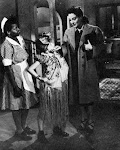.jpg)
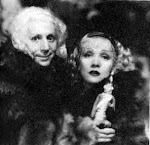+(3).jpg)
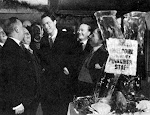+(4).jpg)
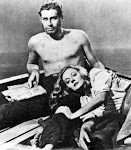+(7).jpg)
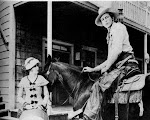.jpg)
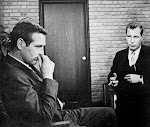+(6).jpg)
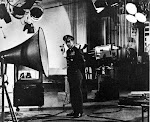+(5).jpg)
.jpg)


